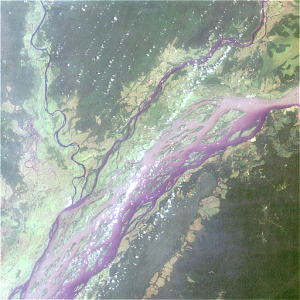Tropical wetlands are one of the most important sources of methane and carbon emissions, which means these land areas play a key role in climate change. Hydrology and hydrodynamics in the tropical wetlands are controlling factors of plant and animal ecosystems, sediment delivery, nutrient exchange and global climate change.
Ting Yuan, a civil engineering Ph.D. student at the UH Cullen College of Engineering, won NASA’s Earth and Space Science Fellowship (NESSF) for the 2015-2016 academic year for her research investigating surface water fluxes over the Congo River Basin using one-dimensional and two-dimensional linear diffusion models combined with satellite remote sensing data. Yuan began working on this research with her faculty advisor, assistant professor Hyongki Lee, in 2012.
According to the NASA website, the purpose of NESSF is to ensure continued training of a highly qualified workforce in disciplines needed to achieve NASA's scientific goals. The award provides a maximum of $30,000 in funding each year for up to three years. Out of 391 earth science proposals submitted to the NESSF program, only 64 were chosen to receive the prestigious fellowship.
With a surface area of approximately 3.7 million square kilometers, the Congo River Basin is the second largest river basin in the world, surpassed only by the Amazon. Compared to the Amazon, though, the Congo Basin is still a mystery. Its remote location combined with political instability in the region has prevented researchers from gathering even the most basic information about the hydrology and hydrodynamics of the Congo’s waters and their connections to global climate change.
Until now, many researchers hypothesized that the hydrology and hydrodynamics of the Congo floodplain were similar to that of the Amazon, Lee said. However, by combining synthetic aperture radar images, satellite altimetry data, and multispectral images collected from NASA, the Japan Aerospace Exploration Agency (JAXA) and the European Space Agency (ESA), Yuan was able to show that these wetlands could be far different than the Amazon Basin.
“What we see is that most of the water stored in the floodplains in the Congo River Basin are from upland runoff or direct rainfall,” Yuan said. “In the Amazon, the floodplains are filled mostly from the river itself rather than from runoff. So, the Congo Basin is quite opposite from the Amazon Basin.”
By integrating the different satellite data sets with the hydrology and hydrodynamics model that she developed, Yuan was able to produce 2-D, high-resolution water level maps illustrating the water levels throughout the Congo floodplains. After rendering of the 2-D models is complete, Yuan will be able to quantify the fine-scale hydrologic fluxes in the floodplains and investigate their seasonal and annual variations.
“By completing this research we will have a better understanding of global hydrology by understanding the Congo River Basin,” said Lee. “The hydrology of the Congo Basin has an impact on climate change as well as the global water cycle, and we will have answers to many of those questions by the end of this research.”
Moreover, because the floodplains of the Congo Basin receive most of its water from upland runoff rather than the river itself, damming projects along the Congo River may not have as much as an environmental impact in the wetlands as it would in the Amazon Basin.
This insight is particularly significant considering hydropower generation projects proposed in the Congo Basin, such as the Inga dam. The so-called Grand Inga project has the potential to provide power to almost the entire African continent, generating twice the power of the Three Gorges Dam in China. The proposed dam would be located about 30 miles from the mouth of the Congo River, where powerful waterfalls and rapids are located.
“This work can help regulators make important decisions about hydropower generation projects in vital basins such as the Congo,” Yuan added.
Yuan said she hopes to continue her research in her career after graduation from the Cullen College, but remains open to job prospects in industry as well. “I received a lot of guidance from Dr. Lee. He is very supportive and I learn a lot from working with him,” Yuan said. “I feel well prepared for what might be next [after completing my Ph.D.], so I am quite open to career options.”
Yuan added that receiving the NESSF fellowship was one of the highlights of her academic career. “I am very honored and grateful I got the fellowship this year,” she said.
